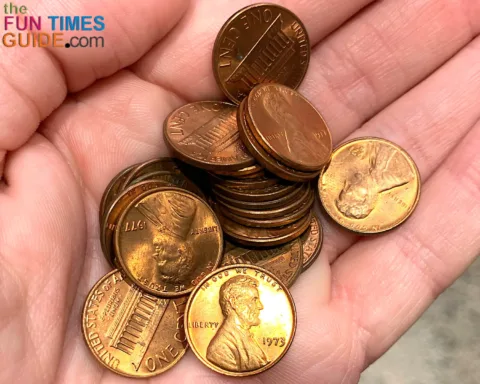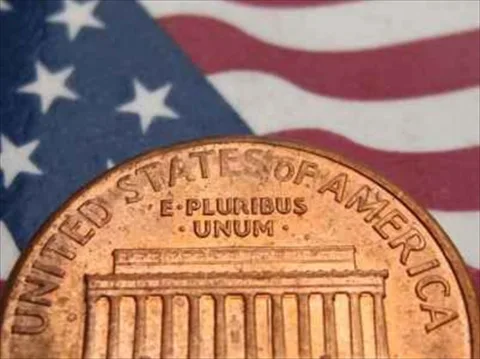Have you got any pre-1983 pennies?
I always save copper pennies from my pocket change and from searching through coin rolls — it’s definitely worth it!
MUST READ: Should You Hoard Copper Pennies?
I’ve been saving this particular batch of pre-1983 bronze Lincoln Memorial cents in a coffee can for a few years now.
I usually manage to accumulate around 1,500 pennies every 3 years or so.
Then, I go through them all, one by one — looking for errors and varieties that are worth more.
What Makes Pre-1983 Pennies Worth Holding Onto?
The thing that makes Lincoln pennies dated before 1983 worth more than face value is their copper content. (Due to the price of copper, they’re worth double face value — around 2 cents apiece right now!)
For me, this has been a profitable way to search through coins in circulation. I mean, you might not make a ton of money doing this — but:
- It’s fun — because you never know what you’re going to find!
- It can be profitable — if you happen to find rare coins, or even just coins that are less common that most.
- If you’re building a collection from circulation finds, it’s a great way to fill a coin album or a coin folder.
Today, I’m going to:
- Show you all of the valuable coins that I found in this batch of 1,475 pennies; and
- Give you a list specific coins you should be looking for among your pre-1983 pennies!
Valuable Pre-1983 Pennies I Found
So… out of a total of 1,475 pennies that I had saved in this can, I actually found quite a few valuable errors and varieties!
Here’s what I found:
- 70 or so coins that have no evidence of wear — so essentially, they’re uncirculated! They all show complete luster at all angles, even on the high points. Because of that, they’re worth a lot more than face value — around 5 to 10 cents apiece! (And remember, all pre-1983 pennies are worth about 2 cents apiece… even when they show signs of wear.)
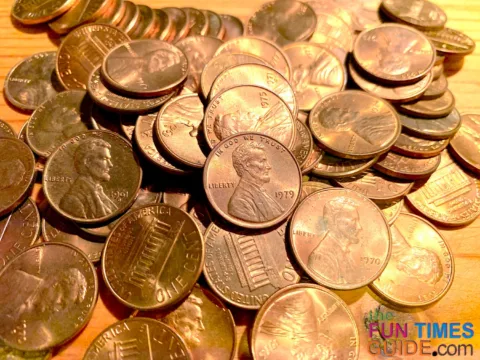
- Several 1972 Lincoln cents with minor hub doubling in the date and the inscription. They’re worth a few dollars each. (The year 1972 is noteworthy because it’s the year the United States Mint struck a number of different kinds of doubled dies.)
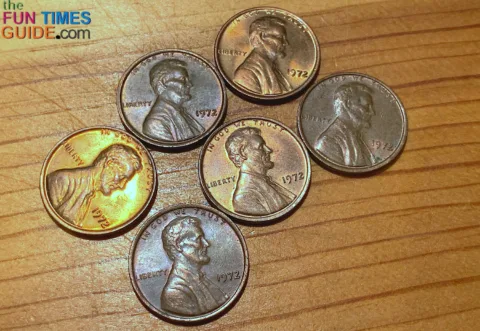
- A couple of 1960 small dates — which are slightly more valuable than large dates.
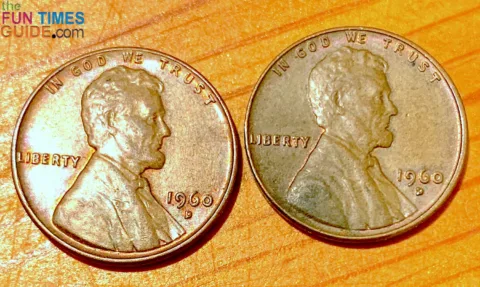
- A few wheat pennies — wheat pennies from any year are worth at least 5 cents apiece. Several are worth much more than that.
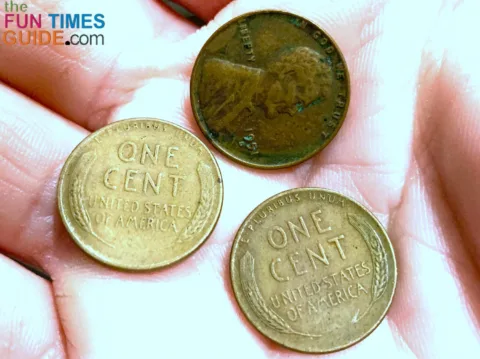
Other Valuable Pre-1983 Pennies To Look For
In addition to looking for each of the above in your own collection of pre-1983 pennies, you should look for these valuable pennies as well:
- 1960 small date (and 1960-D small date) — 50 cents and up
- 1969-S doubled die — $40,000+
- 1970-S small date — $25+
- 1972 doubled die — Class I is worth about $200+, lesser examples worth $10+
- 1982-D small date bronze — Worth up $19,000
- Off-center errors — $3+
- Repunched mintmarks — $3+
- Die cracks and die clashes — $1.50+
In my tin can of old pennies, I also found a handful of other interesting coins — including a 1976 penny with a counterstamp of the state of Kansas on it.
U.S. pennies with counterstamps of various states on them were created by private mints to commemorate the Bicentennial — the 200th birthday of our nation’s existence in 1976.
There are people who collect coins with counterstamps on them — so there’s some value in this one that I found. But I just think it’s a neat find to hold aside and not spend.
You can see each of my valuable coin finds in this video:
What Are Pennies Made Of?
Here’s a rundown of the metal composition of all pennies made in the United States — their base metals and weight:
The very first U.S. penny (produced from 1793 to 1794) was made of 100% copper and weighed 13.48 grams.
From 1795 to 1857, U.S. pennies were made of 100% copper, but they were smaller in size and weighed 10.89 grams.
From 1856 to 1864, U.S. pennies were made of 88% copper and 12% nickel — they weighed 4.67 grams.
From 1864 to 1942, U.S. pennies were made of bronze (95% copper, 5% zinc and tin) and weighed 3.11 grams.
For the 1943 year only, the U.S. penny became a zinc-coated steel penny, weighing 2.72 grams.
From 1944 to 1981, U.S. pennies were made of 95% copper and 5% zinc — they weighed 3.11 grams.
From 1947 to 1962, bronze U.S. pennies were also made (95% copper, 5% zinc and tin), weighing 3.11 grams.
From 1982 to the present, U.S. pennies have been made either mostly of copper or mostly of zinc:
- Brass pennies (made of 95% copper and 5% zinc) weigh 3.11 grams
- Copper-plated zinc pennies (made of 97.5% zinc, 2.5% copper) weigh 2.5 grams.
Wondering which scale you should be using to use to weigh your coins?
For weighing U.S. coins, I like the Weigh Gram coin scale best.
More Info About Old Copper Pennies
- How To Tell Large Date vs Small Date Pennies & Copper vs Zinc Pennies
- 1982 Was A Transitional Year For Lincoln Pennies… See Why
- The Value Of Old Pennies And Which Ones To Keep
- There’s A Rare 1983 Penny Worth $15,000!
- There’s A Rare 1982 Penny Worth $19,000!
- Thinking Of Melting Pennies? It’s Illegal To Melt Pennies For Their Copper Value
I’m the Coin Editor here at TheFunTimesGuide. My love for coins began when I was 11 years old. I primarily collect and study U.S. coins produced during the 20th century. I’m a member of the American Numismatic Association (ANA) and the Numismatic Literary Guild (NLG) and have won multiple awards from the NLG for my work as a coin journalist. I’m also the editor at the Florida United Numismatists Club (FUN Topics magazine), and author of Images of America: The United States Mint in Philadelphia (a book that explores the colorful history of the Philadelphia Mint). I’ve contributed hundreds of articles for various coin publications including COINage, The Numismatist, Numismatic News, Coin Dealer Newsletter, Coin Values, and CoinWeek. I’ve authored nearly 1,000 articles here at The Fun Times Guide to Coins (many of them with over 50K shares), and I welcome your coin questions in the comments below!

